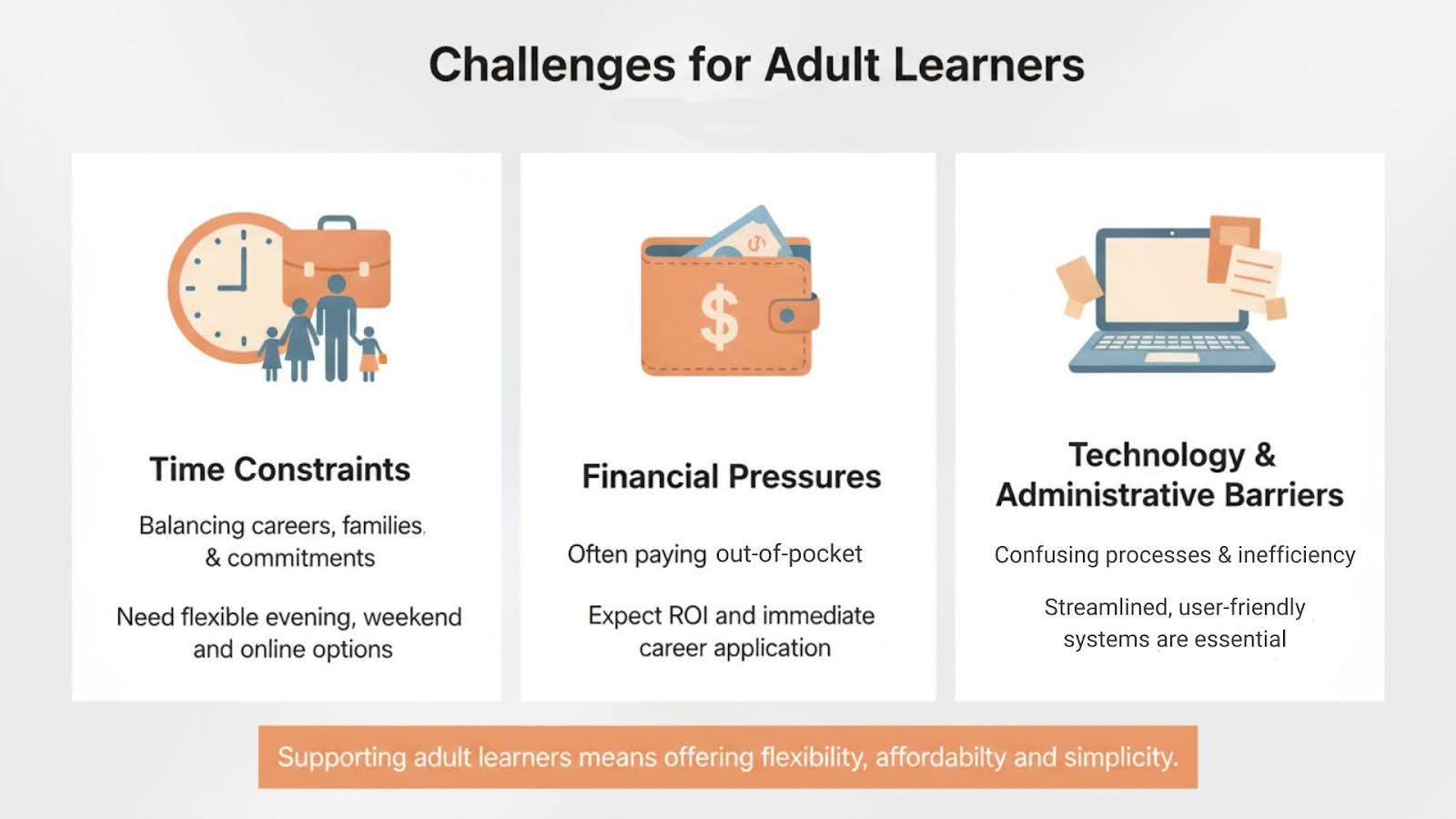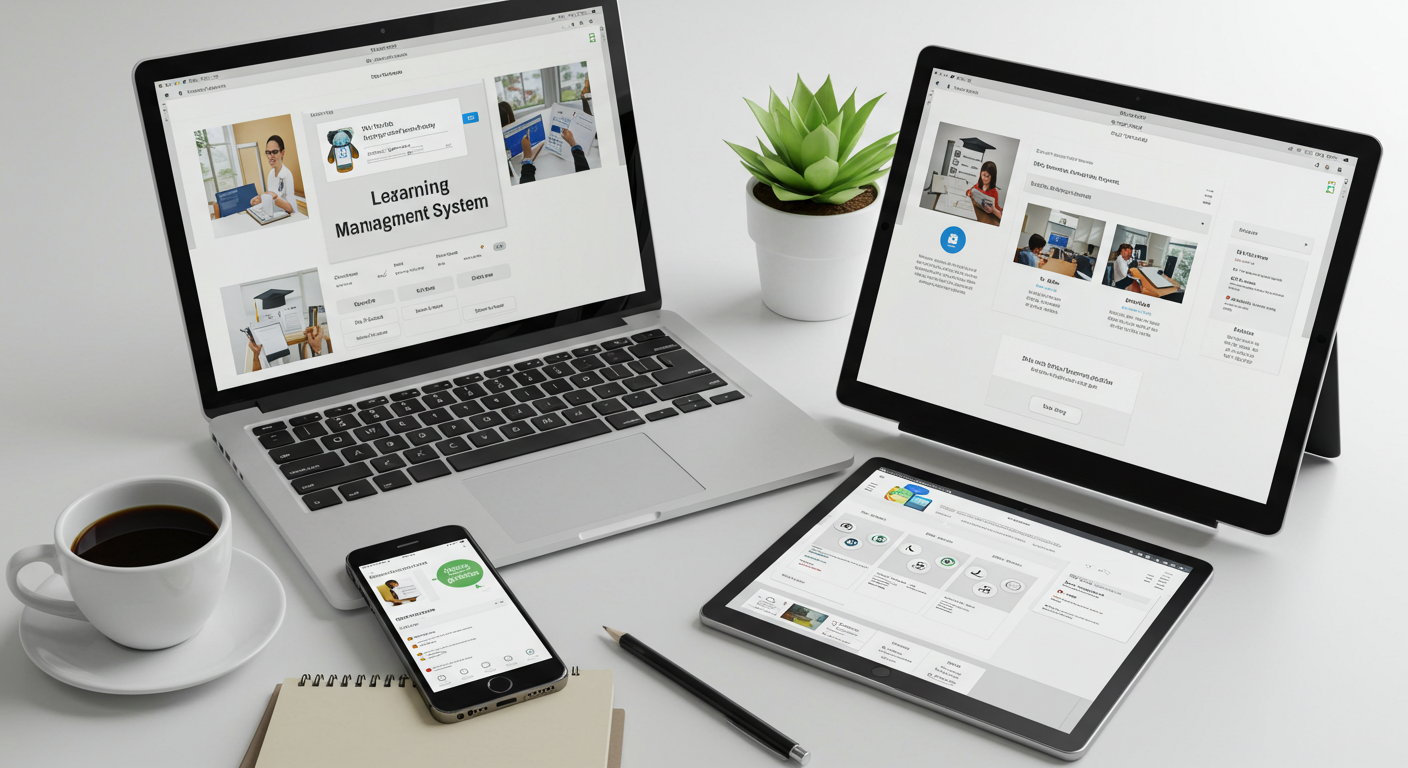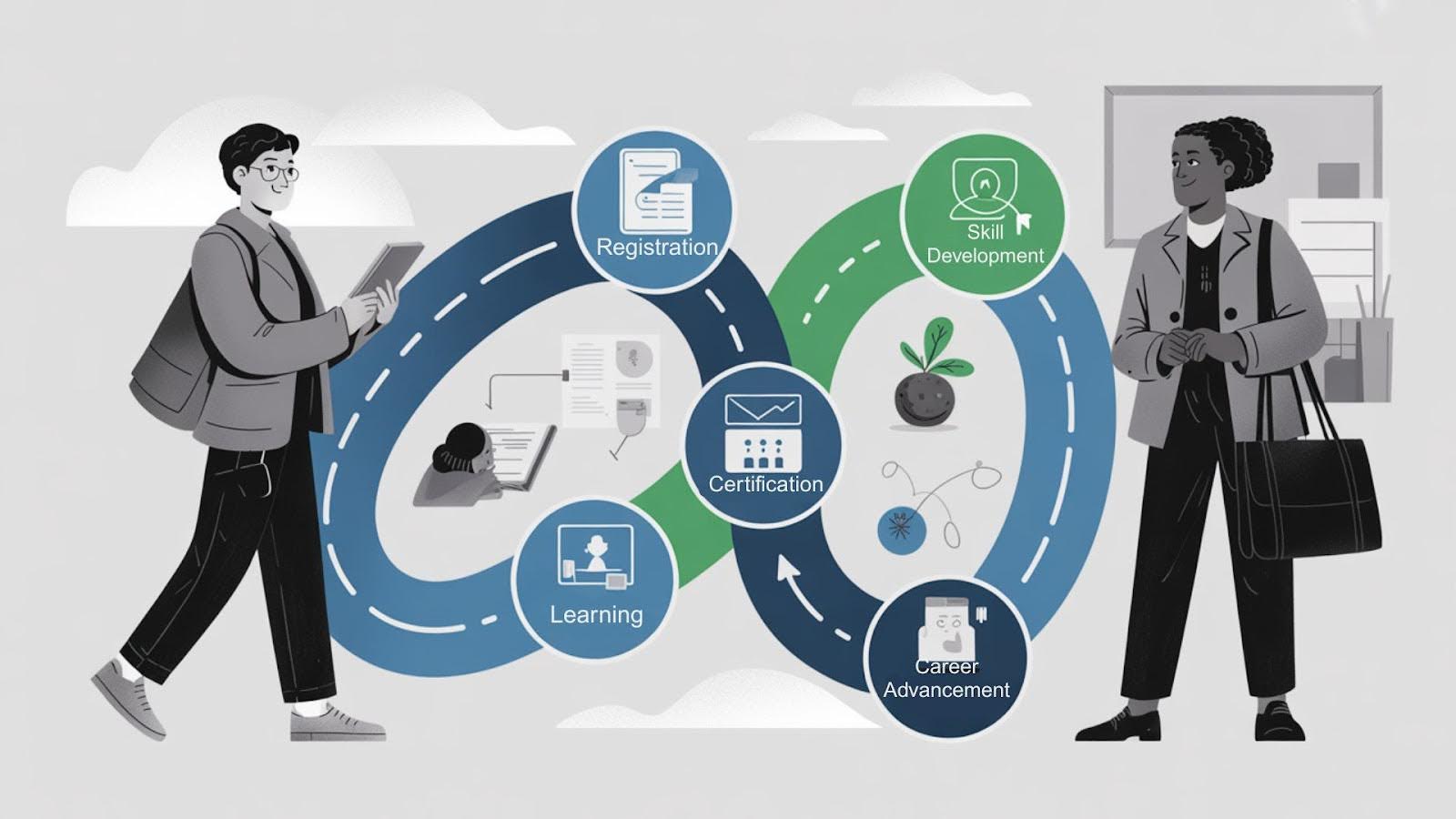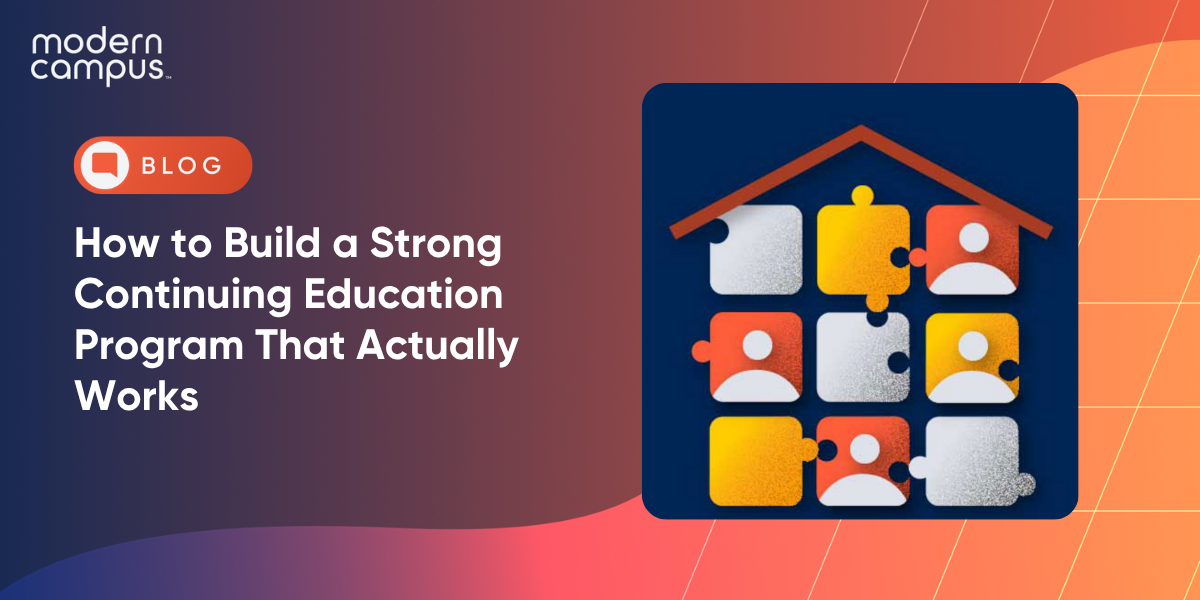How to Build a Strong Continuing Education Program That Actually Works
Traditional higher education enrollment is declining while demand for continuing education explodes, creating massive opportunities for institutions willing to adapt.
- Adult learners now represent a significant portion of students, with a majority preferring non-degree alternatives.
- Certificate program enrollment is growing.
- Modern catalog management systems help institutions reduce course catalog production time.
- Successful programs focus on workforce alignment, flexible delivery and seamless student experiences.
The era of one-and-done education is officially over. Institutions that embrace lifelong learning will dominate the next decade.
While traditional 18- to 22-year-old enrollment continues its decline, a different story is unfolding in continuing education divisions across the country. These programs are thriving amid the current challenges facing higher education.
Recent enrollment data shows that while traditional pathways face challenges, continuing education programs are experiencing growth. Undergraduate certificate program enrollment increased 7.3% in fall 2024, demonstrating sustained demand for flexible, career-focused learning options.
This data implies a shift toward lifelong learning that smart institutions are already capitalizing on. The question is whether your institution can build a strong continuing education program that can compete.
Why Are Continuing Education Programs Essential for Modern Institutions?
Higher education faces challenges that make continuing education programs essential for survival. Traditional revenue streams are under pressure, state funding continues to decline, and prospective students are questioning the value proposition of expensive degree programs.
Meanwhile, the professional landscape demands constant skill updates. 50% of workers will require updated skills every 5 years, creating a massive, sustainable market for institutions that can deliver relevant, accessible continuing education.
Adult learners bring distinct advantages. They're motivated, goal-oriented and often willing to pay premium prices for education that directly impacts their career trajectory. Unlike traditional students who may change majors multiple times, continuing education participants typically know exactly what they want and why they're investing in it.
What Challenges Do Adult Learners Face in Traditional Systems?
Understanding the specific needs of adult learners is essential for building an effective continuing education program. Unlike traditional students, adult learners juggle competing priorities that make conventional educational approaches ineffective.

Time constraints top the list of challenges. Most adult learners are balancing full-time careers, family responsibilities and other commitments. They need educational options that fit around their existing schedules, not the other way around. This means offering evening classes, weekend options and flexible online components that allow them to progress at their own pace.
Financial considerations also differ. While traditional students often receive family support or qualify for extensive financial aid, adult learners typically pay out of pocket or seek employer reimbursement. They expect clear return on investment calculations and want to see immediate application of their learning to their current roles.
Technology barriers create additional friction. Complex administrative processes and confusing paperwork frustrate time-pressed adult learners who expect streamlined, customer-service-level experiences. For working professionals balancing multiple responsibilities, administrative inefficiency can be a deal-breaker that drives them to seek education elsewhere.
How Can Institutions Design Programs That Meet Market Demands?
Successful continuing education programs start with market alignment. Rather than offering courses based on faculty expertise alone, forward-thinking institutions conduct regular workforce needs assessments to identify skill gaps in their regional economy.
Labor market data integration has become essential. Programs that provide real-time salary projections, job growth forecasts and skill demand analytics help learners make informed decisions about their educational investments. This transparency builds trust and demonstrates institutional commitment to learner success.
Flexible program structures accommodate diverse learning preferences and schedules. The most successful programs offer multiple pathways, including intensive bootcamp-style formats for rapid skill acquisition, part-time evening programs for working professionals and self-paced online options for maximum flexibility. Micro-credentialing and stackable certificates allow learners to build expertise incrementally without committing to lengthy degree programs.
Partnership with local employers creates win-win scenarios. Companies get access to trained talent aligned with their specific needs, while institutions gain insight into emerging skill requirements and potential funding for program development. These partnerships often lead to guaranteed job placement or advancement opportunities for program graduates.
What Role Does Technology Play in Modern Continuing Education?
Technology has transformed from a nice-to-have feature to an absolute requirement for competitive continuing education programs. The LMS market is expected to reach $70.83 billion by 2030, driven primarily by demand from non-traditional learners who expect seamless digital experiences.

Modern continuing ed management software automates routine administrative tasks that previously consumed significant staff time. Automated enrollment workflows, payment processing and transcript management free up administrators to focus on program development and student support rather than paperwork processing.
Real-time progress tracking and analytics provide insights that benefit both learners and administrators. Students can monitor their advancement toward certification requirements, while administrators gain visibility into engagement patterns, completion rates and areas where additional support might be needed.
Mobile accessibility has become non-negotiable. With 87% of households having smartphones, computers or tablets, adult learners expect to access course materials, submit assignments and communicate with instructors from any device at any time.
Integration capabilities ensure that continuing education systems work harmoniously with existing campus infrastructure. Rather than creating data silos, modern platforms connect with student information systems, financial aid processing and alumni management tools to provide comprehensive student lifecycle support.
Essential Features of Effective Continuing Education Management
Building a successful continuing education program requires the right technological infrastructure to support both learners and administrators. The most effective programs share several key characteristics that distinguish them from less successful initiatives.
Streamlined Enrollment and Registration: The registration process often represents a prospective student's first substantial interaction with your institution. Complex, multi-step processes with confusing navigation can derail enrollment before it begins. Effective systems offer intuitive, mobile-responsive registration that can be completed in minutes rather than hours.
Automated Administrative Workflows: Administrative efficiency directly impacts program profitability. Systems that automate routine tasks like payment processing, enrollment confirmations and prerequisite verification reduce staff workload while minimizing opportunities for human error. This automation allows staff to focus on student support and program development.
Comprehensive Progress Tracking: Adult learners want transparency about their advancement toward program completion. Robust tracking systems provide real-time visibility into completed coursework, remaining requirements and projected completion dates. This visibility helps learners plan their schedules and maintain motivation throughout longer programs.
Integrated Financial Management: Continuing education often involves complex pricing structures, employer reimbursements and payment plans. Integrated financial management tools handle these complexities while providing clear reporting for both students and institutional accounting departments.
Multi-Modal Learning Support: The most successful programs offer learning experiences that accommodate different preferences and schedules. This includes support for live online sessions, self-paced coursework, hybrid formats and in-person intensives, all managed through a unified platform.
How to Measure Success in Your Continuing Education Program
The most successful programs track both leading and lagging indicators to enable proactive program management.

Enrollment conversion rates reveal the effectiveness of marketing efforts and program appeal. This metric tracks the percentage of inquiries that convert to actual enrollments, helping identify bottlenecks in the recruitment process.
Student satisfaction scores provide insight into program quality and the likelihood of word-of-mouth referrals. Regular feedback collection throughout the program lifecycle, rather than just at completion, enables real-time improvements and demonstrates institutional responsiveness to student needs.
Employment outcomes and salary impacts validate program effectiveness from the learner perspective. Tracking graduate placement rates, salary increases, and career advancement helps demonstrate ROI and provides powerful marketing content for future recruitment.
Revenue per student and program profitability metrics ensure sustainable growth. Understanding the true cost of program delivery, including technology, staffing and overhead, enables informed decisions about pricing, capacity and resource allocation.
Long-term engagement measures the strength of relationships beyond initial program completion. This includes alumni participation in advanced programs, referral rates and willingness to engage with the institution for future learning needs.
Success Stories: Real Results from Strong Programs
Harper College provides an excellent example of strategic continuing education program development. Mark Mrozinski, from their continuing education division, emphasized the importance of user-friendly systems: "Our students are constantly learning the system, so we need to offer them something intuitive, which they can easily navigate and which puts up few barriers." Their focus on removing friction from the student experience has resulted in consistently high retention rates despite the challenging nature of adult learner demographics.
The University of Minnesota consolidated all non-credit and continuing education offerings into a unified platform, resulting in significant cost savings and improved student engagement. By streamlining operations and eliminating duplicate systems, they reduced administrative overhead while creating a more coherent experience for students navigating their various program options.
What Does the Future Hold for Continuing Education?
The trajectory toward lifelong learning shows no signs of slowing. Demographic trends, technological advancement and evolving workforce requirements all point toward continued growth in demand for flexible, career-focused education options.

Artificial intelligence integration will enable increasingly personalized learning experiences, with 86% of students already using AI tools for research assistance, writing support and study planning. AI-powered platforms can adapt content delivery based on individual learning patterns, recommend relevant additional coursework and provide predictive analytics about student success likelihood.
Micro-credentialing and digital badges will continue gaining employer recognition as valid indicators of specific competencies. This trend toward granular skill verification supports just-in-time learning approaches that align closely with immediate professional needs.
Employer partnerships will deepen as companies recognize the value of upskilling the existing workforce rather than constantly recruiting new talent. These partnerships often include customized curriculum development, guaranteed enrollment numbers and shared technology investments.
Building Your Institution's Continuing Education Strategy
Successful continuing education programs don't happen by accident. They require intentional strategy, appropriate resources and institutional commitment to serving adult learners. The institutions that thrive in this environment will be those that recognize continuing education as a core component of their mission to support lifelong learning.
The 60-year curriculum model is the future of higher education, where institutions support learners throughout their entire career journey rather than just during a brief period in their early twenties. Building strong continuing education programs positions your institution to be relevant and valuable to students across multiple decades of their professional lives.
Frequently Asked Questions
What makes a continuing education program successful? Successful programs combine market-aligned curriculum with student-centered delivery methods, supported by technology that eliminates administrative friction. The most effective programs maintain close connections with local employers to ensure graduates have immediate application for their new skills.
How can institutions measure ROI for continuing education investments? ROI measurement should include both financial metrics (revenue per student, cost per acquisition) and strategic outcomes (student satisfaction, employment placement rates, institutional reputation enhancement). Success indicators include enrollment growth, program completion rates and graduate employment outcomes.
What technology infrastructure is required for modern continuing education? Modern programs require mobile-responsive registration systems, integrated payment processing, progress tracking capabilities and seamless communication tools. The platform should integrate with existing campus systems while providing continuing education-specific functionality.
How do successful institutions balance academic rigor with professional relevance? The most effective approach combines theoretical foundations with immediate practical application. Programs that include case studies, project-based learning and industry partnerships maintain academic standards while delivering obvious professional value.
What support services do adult learners need most? Adult learners prioritize responsive customer service, flexible scheduling options, clear communication about requirements and deadlines and technology support. Unlike traditional students, they typically need less social programming but more logistical assistance.
Upgrade Your Continuing Education Offerings
The opportunity is significant, but so is the competition. Adult learners have more educational options than before, from corporate training programs to online bootcamps to professional certification courses. Institutions that can combine academic rigor with professional relevance, administrative efficiency with personal attention and technological sophistication with human connection will capture the largest share of this growing market.
Modern Campus empowers institutions to create exceptional continuing education programs that attract, engage and retain learners for life. Our integrated platform combines powerful student lifecycle management with intuitive user experiences, helping institutions streamline operations while delivering personalized learning journeys that drive real career outcomes. Request a demo and discover how Modern Campus can help your institution build the programs that tomorrow's learners demand.
Last updated: November 6, 2025
